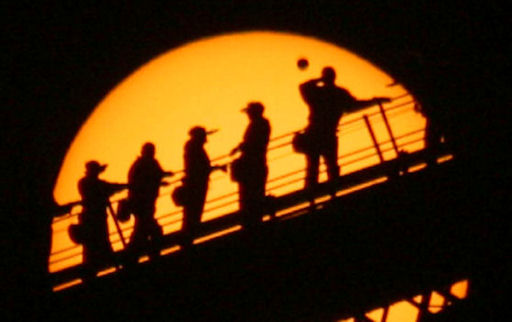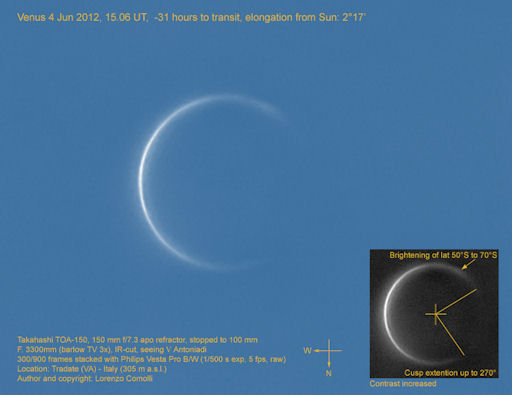SOLAR WIND: A high-speed strem of solar wind is buffeting Earth's magnetic field, setting the stage for possible geomagnetic activity. NOAA forecasters estimate a 60% chance of polar geomagnetic storms during the next 24 hours. Aurora alerts: text, voice.
TRANSIT OF VENUS: No one reading this will still be alive the next time Venus crosses the sun in 2117. That makes today special. On June 5th at 3:09 pm PDT, the second planet begins its historic 7-hour transit of the solar disk. Observers on parts of all seven continents (map) will witness something like this:

Photo credit: David Finlay of Sydney, Australia (June 8, 2004).
The timing favors observers in the mid-Pacific where the sun is high overhead during the crossing. In the USA, the transit will be at its best around sunset. Creative photographers will have a field day imaging the swollen red sun "punctured" by the circular disk of Venus.
Stay tuned to Spaceweather.com's realtime gallery for constantly updated images of the transit. Another photo-stream of interest comes from the International Space Station where Don Pettit will be the first man in history to photograph a Venus transit from space. There are also many live webcasts of the transit from locations around the world: #1, #2, #3, #4. (Submit more webcast links here.)
Realtime Transit of Venus Photo Gallery
[Submit your photos] [NASA videos: 2012 Transit of Venus, ISS Transit of Venus]
Observing Tip: Do not stare at the sun. Venus covers too little of the solar disk to block the blinding glare. Instead, use some type of projection technique or a solar filter. A #14 welder's glass is a good choice. Many astronomy clubs will have solar telescopes set up to observe the event; contact your local club for details.
Transit of Venus Web Links:
- NASA's Transit of Venus home page
- James Cook and the Transit of Venus -- Science@NASA
- Don Pettit and the Transit of Venus -- Science@NASA
- Live images from the ISS --whoa!
BEFORE THE TRANSIT: As Venus approaches the sun, it turns its nightside toward Earth. This turning transforms Venus into a rarely-seen thin ring of light. Lorenzo Comolli photographed the phenomenon from Tradate, Italy, on June 4th:
The effect is caused by particles in upper layers of Venus's atmosphere which scatter sunlight around the circumference of the planet. The ring is very difficult to observe, and often only black-belt astrophotographers are able to record the phenomenon.
"This picture was taken while Venus was a scant 2°17' from the sun's center, and it was very difficult to obtain due to the extreme proximity of the solar limb," says Comolli. "Extreme care was due to avoid the sun light entering the telescope. The extension of the crescent to form a nearly complete ring was remarkable on June 4, while nearly invisible on June 2. Another interesting observation is the limb brightening in Venus's southern hemisphere between 50° to 70° latitude. For confirmation, I obtained a second image using a W25 filter (red) that shows the presence of the brightening in the same way."
more images: from Tobias Kampschulte of Gennadi, Rhodes, Greece; from Steve Miller of Lake Havasu City, Arizona: from Antonios Pantelidis of Florina, Greece; from Rob of Liverpool, UK; from Elias Chasiotis of Markopoulo, Greece; from Pavol Rapavy of Observatory Rimavska Sobota, Slovakia; from Ernie Mastroianni of Milwaukee, Wisconsin; from Joe Mcbride of Grand Rapids, Michigan

![]()
Solar wind
speed: 658.2 km/sec
density: 1.4 protons/cm3
explanation | more data
Updated: Today at 1526 UT
![]()
X-ray Solar Flares
6-hr max: C1 1157 UT Jun05
24-hr: C1 1157 UT Jun05
explanation | more data
Updated: Today at: 1500 UT
![]()
![]()
![]()
Daily Sun: 05 Jun 12
![]()
![]()
Many spots, few flares: Solar activity is low despite the high sunspot number. Credit: SDO/HMI
![]()
![]()
![]()
Sunspot number: 155
What is the sunspot number?
Updated 04 Jun 2012
Spotless Days
Current Stretch: 0 days
2012 total: 0 days (0%)
2011 total: 2 days (<1%)
2010 total: 51 days (14%)
2009 total: 260 days (71%)
Since 2004: 821 days
Typical Solar Min: 486 days
Updated 04 Jun 2012
The Radio Sun
10.7 cm flux: 128 sfu
explanation | more data
Updated 04 Jun 2012
![]()
![]()
![]()
Current Auroral Oval:
![]()
Switch to: Europe, USA, New Zealand, Antarctica
Credit: NOAA/POES
![]()
![]()
![]()
Planetary K-index
Now: Kp= 4 unsettled
24-hr max: Kp= 4 unsettled
explanation | more data
![]()
Interplanetary Mag. Field
Btotal: 5.7 nT
Bz: 0.5 nT south
explanation | more data
Updated: Today at 1526 UT
![]()
![]()
![]()
Coronal Holes: 04 Jun 12
![]()
![]()
Earth is inside a high-speed stream of solar wind flowing from this coronal hole. Credit: SDO/AIA.





